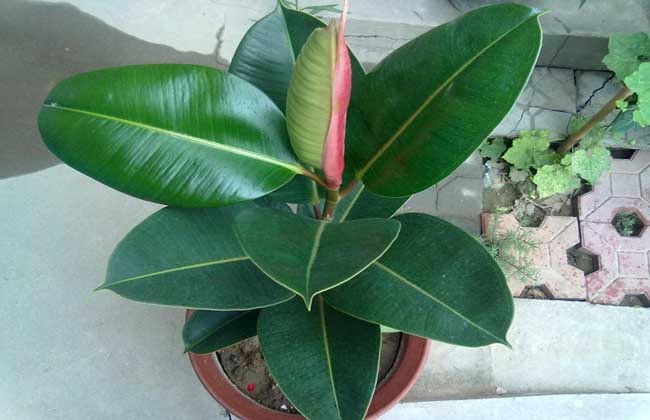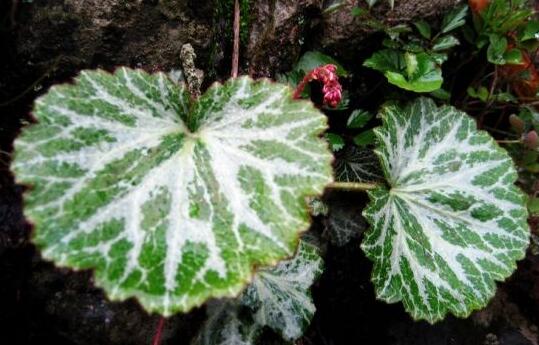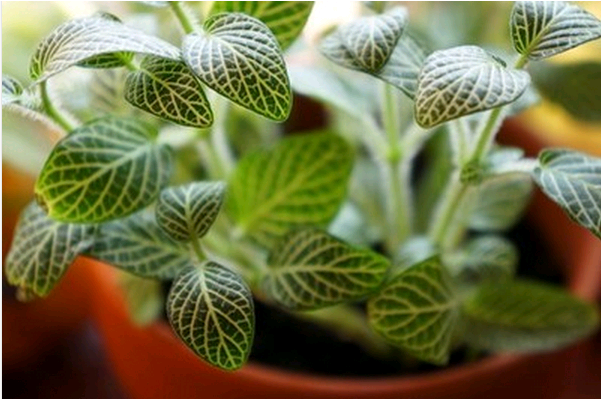How to raise potted rubber trees
How to raise potted rubber trees, rubber trees have broad and thick leaves, bright leathery, evergreen all the year round, and are good potted foliage plants.
(1) the regulation of light. Rubber trees like light and need medium or above intensity of light, but avoid direct light in summer so as not to cause leaf burns; in winter, they should be placed near the south window with sufficient indoor light, if placed in shade for a long time, it is easy to cause leaves to yellowing or falling leaves. Rubber tree has a stubborn nature, do not easily move the flowerpot, but if it is too strong in a certain direction, it should be appropriate to change direction, so that its growth is balanced.
(2) temperature adjustment. Rubber trees prefer high temperature environment, and the suitable temperature for growth is 25-30 ℃, but when it is more than 35 ℃, it should be moved to a cool and ventilated place. In winter, the room temperature should be kept above 10 ℃, otherwise the leaves will turn black and fall off. Long-term low temperature and damp basin soil are also easy to cause root rot.
(3) watering. Rubber trees like water, so it is necessary to ensure an adequate water supply during the growth period and keep the soil moist. In the summer high temperature season, water is watered once in the morning and evening every day, and water is sprayed on the leaves many times. The amount of watering is gradually reduced in autumn and should be controlled in winter. Leathery leaves do not have high requirements for air humidity and adapt to a drier environment, but they need to be washed with water frequently to keep them fresh.
(4) fertilization. Rubber trees like fertilizer, and can apply nitrogen-based compound fertilizer or rotten thin cake fertilizer and water once a month when the temperature is about 25 ℃. When young trees change pots every year, humus and basal fertilizer should be added to the basin soil. When the adult plants of 4 ~ 8 years are planted in a barrel and topdressing 3-4 times a year, the branches and leaves can flourish.
(5) the preparation of culture soil. Potted rubber trees require the soil to be fertile, moist, rich in humus and slightly acidic. Peat soil, rotten leaf soil and river sand are commonly used and mixed with a small amount of base fertilizer. the above is an introduction to how to raise potted rubber trees.
How to raise potted rubber trees?

Rubber tree is a large tree plant of the genus Ficus of Moraceae, also known as rubber tree, Brazilian rubber, etc., with high ornamental value. It is a famous potted foliage plant, which is very suitable for indoor beautification. Small and medium-sized plants are often used to beautify the living room and study. Medium and large plants are suitable to be arranged on both sides of the foyer of large buildings and in the center of the lobby. Let's take a look at how to raise potted rubber trees.
Growth habits of rubber trees
Rubber tree is native to Brazil and is widely cultivated in tropical Asia. It is cultivated in Taiwan, southern Fujian, Guangdong, Guangxi, Hainan and southern Yunnan, especially in Hainan and Yunnan. Sex like high temperature, humid, sunny environment, suitable growth temperature 20: 25 ℃, avoid direct sunlight. It is also shady but not cold-resistant, and the safe overwintering temperature is 5 ℃. Resistant to air dryness. Avoid clayey soil, not resistant to barren and drought, like loose, fertile and well-drained slightly acidic soil.
The method of planting rubber trees
1, cutting: cutting time in late spring and early summer, can be combined with pruning, cuttings choose more than 1-year-old semi-lignified middle branches, cuttings in plain sand or frog stone as the matrix of the cutting bed, after cutting to maintain a high humidity, but not stagnant water, the appropriate temperature is 18-25 ℃, often sprinkle water to the ground to improve air humidity, and do a good job of shading and ventilation, about 2 weeks to take root.
2. Striping: select 2-year-old branches with appropriate size, good development and well-developed tissue, make a light circular peeling of about 1 cm in width in the intended part of the wrapped soil, and apply 30~50ppm 's naphthalene acetic acid solution, then wrap the ring cutting part with a mixture of wet soil or moss or vermiculite that absorbs enough water, wrap it with plastic film on the outside, tie it tightly at the lower end, and leave holes at the upper end for ventilation and irrigation. It was pressed in June and took root from July to August. After taking root, the potted plant could be cut off.
How to raise potted rubber trees?
1. Soil: rubber trees like loose, fertile and slightly acidic soil with good drainage, and are not resistant to barren. The culture soil can be mixed with rotten leaf soil, garden soil and river sand, and a small amount of cake fertilizer is applied as base fertilizer, usually turning the basin once every two years.
2. Temperature: the rubber tree likes the high temperature environment, so it grows most rapidly in summer and autumn, and the ambient temperature should be kept between 20 and 30 degrees. When the ambient temperature is lower than 10 degrees, the growth of the rubber tree is basically stagnant. The overwintering temperature should not be lower than 5 degrees.
3. Lighting: rubber trees like strong direct sunlight and are resistant to shady environment. However, in the process of cultivation, it should be exposed to not less than 4 hours of direct sunlight every day. If there are conditions, it is best to ensure that the plant can accept all-day sunlight.
4. Fertilization: rubber trees like fertilizer, but avoid nitrogen fertilizer. When there is too much nitrogen fertilizer, the stem node is only long, the leaf spacing is enlarged, and the plant shape is not beautiful. In the growing season, the young plants were topdressing 10 times of rotten liquid fertilizer mixed with 500x potassium dihydrogen phosphate once every 20 days, or 1000 times of Huaduoduo general fertilizer twice. In order to control the height of the formed plant, the mixed liquid fertilizer can be applied once every two months in the growing season.
5. Watering: rubber trees like to be wet, but avoid waterlogging and are not resistant to drought. Spring and autumn should make the basin soil in a moist state, and often sprinkle water to its leaves and around to increase air humidity. Rubber trees need a lot of water in summer, and they need to be watered every day to keep the basin soil moist and increase the frequency of watering. When the temperature is low in winter, it is better to water the basin soil moist.
6. Pruning: pruning the canopy in spring, deleting the bifurcated branches, introverted branches, withered branches and weak branches inside the crown, and truncating the branches protruding from the crown, so as to make the plant well ventilated and light permeable and keep the tree shape round. If the crown is too large, the outer branches can be truncated as a whole. Dense branches and short truncated branches should be removed at any time during growth.
Matters needing attention of rubber trees
1. The suitable temperature for rubber tree growth is 25: 30 ℃. If the leaf is lower than 3 ℃ in winter, the leaves will turn yellow and fall off, so it should be placed in the sunny place indoors in winter and keep the room temperature above 10 ℃. When more than 35 ℃ in summer, the plant should be moved to a cool and ventilated place for maintenance, and timely water spray to cool down.
2. Rubber tree is a plant of Moraceae, and the whole plant contains milk. Therefore, immediately after each pruning, the incision should be blocked with cement or coated with charcoal powder, so as not to drain too much juice and cause water loss and death.
3. Rubber trees need to change the direction of the pot regularly in the seedling stage in order to prevent the plant from growing on one side, resulting in small and correct plant shape and beautiful appearance.
4. After the growth of rubber tree seedlings, the roots are getting bigger and bigger, which causes soil hardening, hinders soil ventilation, and causes rubber trees to turn yellow and die seriously. It is advisable to change the basin before the new buds grow every spring and loosen the soil every 15 to 20 days until it returns to normal growth. How to raise rubber trees, the cultivation methods of potted rubber trees are also known as big leaf green, red Burmese tree, red mouth rubber tree, film protection tree, Burmese banyan, Burma tree, banyan milk tree, elastic film protection tree, evergreen, rubber tree, Indian rubber banyan, Indian banyan, Indian rubber tree and so on. It is an ornamental plant of the genus Ficus, Moraceae, and its origin is India. Its management is not complicated, even if people who lack cultivation experience can cultivate it well.
The growth habits of rubber trees: rubber trees like warm, humid, sunny environment, but also slightly shady, not cold-resistant. It is required to have fertile and loose soil and grow well in neutral or acidic soil. When potted, it is appropriate to use rotten leaf soil, grass ash soil plus about 1 to 4 river sand and a small amount of base fertilizer to form culture soil. Usually keep the soil moist and apply dilute liquid fertilizer every 15-20 days. High temperature in summer, rubber trees grow faster, should be fat and water, but to avoid stagnant water in the basin. After entering autumn, fertilization and watering are gradually reduced to promote plant growth and enrichment, which is conducive to overwintering. Because rubber trees like the sun, they should be kept outside in the sun from spring to autumn; if placed in a shaded place for a long time, it is easy to cause leaves to yellowing and falling off. Like sunshine, single also more tolerant to shade, watering more overnight tea, the whole plant should often spray water, and wipe its leaves with a wet cloth, which is beneficial to photosynthesis, because it is not hardy, rubber trees should be moved into the sunny place indoors for maintenance in winter, keeping the room temperature above 10 ℃, and the minimum temperature should not be less than 5 ℃; if the temperature is too low, the basin soil is moist, it will cause leaves to blacken and fall off and root rot, or even the whole plant to die. Move to the courtyard or balcony for maintenance from the end of April to the beginning of May next year. The north should pay attention to the change of season from indoor to outdoor can not immediately receive strong sunlight, that is, the light and temperature should not change too much. If the room temperature is low in winter, a small amount of water should be watered to keep the basin soil slightly tidal. The leaves of the rubber tree are bright, green and pleasant, and its plants are tall and imposing, so they are suitable to be placed on the balcony to green the environment. Display: potted rubber trees can be placed in the east, south, west balcony for management, of which the south balcony cultivation effect is the best. Its plant is relatively tall, suitable for planting on a very spacious balcony. During its vigorous growth stage, the plant should be placed where it is exposed to direct sunlight for not less than 2 hours a day. The environment should be kept ventilated in summer. It doesn't matter if the temperature is a little lower in winter. Pot management: it is appropriate to choose sandy loam rich in humus as cultivation substrate. If conditions permit, the basin soil can be made up of rotten leaves, fine sand and garden soil at a ratio of 1:1:2 by volume. Rubber tree plants are relatively tall and grow rapidly, and large flowerpots are usually selected for planting. Rubber trees like micro-tide dry soil environment, summer is the stage where they need the most water and can be watered more; winter is the period when they need the least water, so they should be watered less. In addition to applying about 50 grams of horseshoe slices as base fertilizer at the bottom of the flowerpot during planting, dilute liquid fertilizer should be applied every lO day in the vigorous growth stage. Rubber trees like to shine in direct sunlight and are resistant to shade. If there are conditions, it is best to let the plant be able to accept all-day sunlight. Just keep the environment properly ventilated. Rubber tree is fond of high temperature environment, it grows well in the temperature range of 16 ℃ ~ 30 ℃, and the overwintering temperature should not be lower than 5 ℃. Before the new buds germinate in spring every year, the old branches of the plant are truncated 2 to 3 or 1 to 2 to promote the formation of new branches and prune the inner bore branches and thin and weak branches at the same time. In balcony cultivation, rubber trees are usually rarely sick, but they are vulnerable to grubs. Large plants of more than three years old should be turned once every spring and March. During the operation, some of the old roots can be cut off, some new soil can be replaced, and the branches of the plant can be cut in the middle to promote branching. In this way, the plant has a stronger growth potential, so that the ornamental value is greatly improved. Propagation method: cuttage is the main method of propagation, which is mostly carried out from March to April in spring. Fine sand can be used as propagation substrate. The specifications of the basin can be determined according to the specific needs. Combined with pruning, the newly lignified branches of the rubber tree are cut into single segments with 1 leaf in each segment. White mucus will flow out from the stem incision, which can be washed away with warm water, and then dipped in a small amount of charcoal powder to the surface of the incision. Fill the small flowerpot with fine sand, then insert a bamboo stick about 20 centimeters long, keep the polarity of the cut stem of the rubber tree into the soil, wrap the bamboo stick in the middle of the leaf and tie it with string. Then put the flowerpot containing cuttings into the plastic shed and often spray water to moisturize. Under the condition of 25 ℃ ~ 30 ℃, rubber tree cuttings can take root after about 4 weeks, and can be planted in pots when the seedlings grow 2-3 new leaves. The method of pressing strip can also be used to raise seedlings. The method of inserting rubber leaves into its petiole can produce adventitious roots, but it cannot produce adventitious buds, so it cannot grow into a new individual. Therefore, it is necessary to use leaves or terminal buds with a bud at the base for cutting in order to form new plants. The depth is only the tip of the bud. Insert and cover with a glass cover to prevent the moisture from evaporating. If opposite leaves, can be divided into two halves, each leaf with a bud as a cuttage.
Rubber leaves can be inserted with one leaf and one bud, or one leaf, half or even smaller propagation materials can be used to root quickly in the intelligent control of rapid propagation bed, the whole leaf can be rapidly propagated by 2000PPM, and the rooting effect of half of the leaves treated with 400PPM for 1 hour is the best, and the rooting rate is up to 100%. The picture below shows the rubber tree propagated on 2.21 and its well-developed root system 3.21. At this time, through the treatment of cytokinins, it will not be long before the buds can differentiate into a complete plant.
00 collection and sharing
- Prev

How to grow Saxifraga
How to plant Saxifraga? Saxifraga belongs to Saxifragaceae. Saxifraga is a perennial herb, native to the south of Qinling Mountains in China, with green leaves, white reticular veins, purplish red on the back, white hairs on both sides, similar to Saxifraga, hence the name Saxifraga. Petiole is long, mostly purplish red. From flower to summer
- Next

How to raise reticulate grass? the breeding method of reticulated grass.
How to raise reticulated grass? reticulated grasslands are produced in tropical African jungles. They like cool, hot and humid environments, and grow luxuriantly in high temperature, high humidity and dark environment. South China can be cultivated all the year round in shady greenhouses or air-conditioned rooms. The cultivation temperature of Rhizoma reticulata should be above 18 ℃.
Related
- Fuxing push coffee new agricultural production and marketing class: lack of small-scale processing plants
- Jujube rice field leisure farm deep ploughing Yilan for five years to create a space for organic food and play
- Nongyu Farm-A trial of organic papaya for brave women with advanced technology
- Four points for attention in the prevention and control of diseases and insect pests of edible fungi
- How to add nutrient solution to Edible Fungi
- Is there any good way to control edible fungus mites?
- Open Inoculation Technology of Edible Fungi
- Is there any clever way to use fertilizer for edible fungus in winter?
- What agents are used to kill the pathogens of edible fungi in the mushroom shed?
- Rapid drying of Edible Fungi

